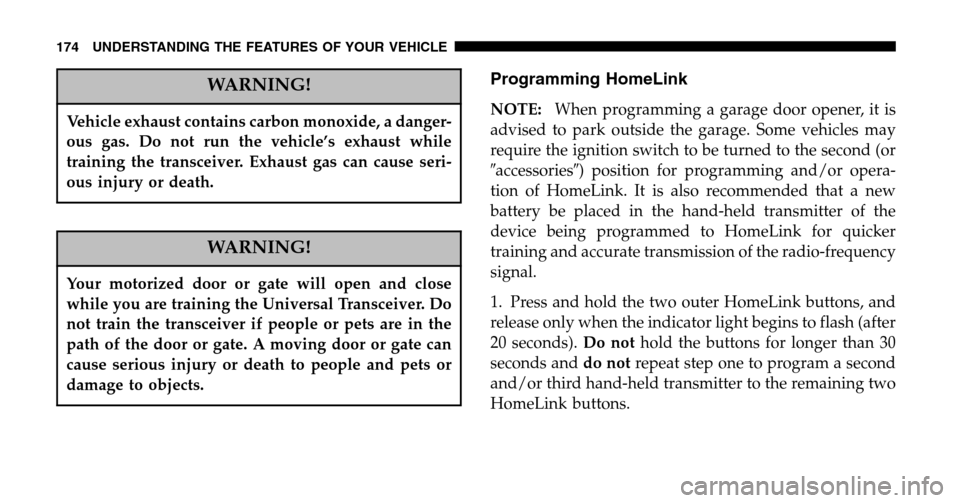Page 174 of 496

WARNING!
Vehicle exhaust contains carbon monoxide, a danger-
ous gas. Do not run the vehicle’s exhaust while
training the transceiver. Exhaust gas can cause seri-
ous injury or death.
WARNING!
Your motorized door or gate will open and close
while you are training the Universal Transceiver. Do
not train the transceiver if people or pets are in the
path of the door or gate. A moving door or gate can
cause serious injury or death to people and pets or
damage to objects.
Programming HomeLink
NOTE: When programming a garage door opener, it is
advised to park outside the garage. Some vehicles may
require the ignition switch to be turned to the second (or
� accessories �) position for programming and/or opera-
tion of HomeLink. It is also recommended that a new
battery be placed in the hand-held transmitter of the
device being programmed to HomeLink for quicker
training and accurate transmission of the radio-frequency
signal.
1. Press and hold the two outer HomeLink buttons, and
release only when the indicator light begins to flash (after
20 seconds). Do nothold the buttons for longer than 30
seconds and do notrepeat step one to program a second
and/or third hand-held transmitter to the remaining two
HomeLink buttons.
174 UNDERSTANDING THE FEATURES OF YOUR VEHICLE
Page 176 of 496

NOTE:To program the remaining two HomeLink but-
tons, begin with �Programming�step two. Do not repeat
step one.
If the indicator light blinks rapidly for two seconds and
then turns to a constant light, continue with �Program-
ming � steps6-8 to complete the programming of a
rolling code equipped device (most commonly a garage
door opener).
6. At the garage door opener receiver (motor-head unit)
in the garage, locate the �learn�or�smart� button. This
can usually be found where the hanging antenna wire is
attached to the motor-head unit.
7. Firmly press and release the �learn�or�smart� button.
(The name and color of the button may vary by manu-
facturer.)
NOTE: There are 30 seconds in which to initiate step
eight. 8. Return to the vehicle and firmly
press, hold for two
seconds and release the programmed HomeLink button.
Repeat the �press/hold/release �sequence a second time,
and, depending on the brand of the garage door opener
(or other rolling code equipped device), repeat this
sequence a third time to complete the programming.
HomeLink should now activate your rolling code
equipped device.
NOTE: To program the remaining two HomeLink but-
tons, begin with �Programming�step two. Do not repeat
step one . For questions or comments, please contact
HomeLink at www.homelink.com or 1-800-355-3515 .
Canadian Programming/Gate Programming
Canadian radio-frequency laws require transmitter sig-
nals to �time-out �(or quit) after several seconds of
transmission which may not be long enough for
HomeLink to pick up the signal during programming.
176 UNDERSTANDING THE FEATURES OF YOUR VEHICLE
Page 199 of 496
UNDERSTANDING YOUR INSTRUMENT PANEL
CONTENTS
�Instruments And Controls .................205
� Base Instrument Cluster ..................206
� Instrument Cluster With Tach ..............207
� Premium Instrument Cluster ...............208
� Instrument Cluster Descriptions ............209
� Electronic Digital Clock ..................217
▫ Clock Setting Procedur e.................217
� Radio General Information ................217
▫ Radio Broadcast Signals .................217 ▫
Two Types Of Signals ..................218
▫ Electrical Disturbances ..................218
▫ AM Reception .......................218
▫ FM Reception ........................218
� Sales Code RAZ—AM/ FM Stereo Radio With
Cassette Tape Player, CD Player And CD Changer
Controls .............................219
▫ Operating Instructions — Radio ...........219
▫ Power Switch, Volume Control ............219
▫ Seek Button (Radio Mode) ...............2194
Page 200 of 496

▫Tuning .............................220
▫ Radio Data System (RDS) ...............220
▫ PTY (Program Type) Button ..............220
▫ Balance ............................222
▫ Fade ..............................222
▫ Tone Control ........................222
▫ AM/FM Selection .....................222
▫ Scan Button .........................222
▫ To Set The Radio Push-Button Memory ......223
▫ To Change From Clock To Radio Mode ......223
▫ Operating Instructions — Tape Player .......223
▫ Seek Button .........................223
▫ Fast Forward (FF) .....................224 ▫
Rewind (RW) ........................224
▫ Tape Eject ...........................224
▫ Scan Button .........................224
▫ Changing Tape Direction ................224
▫ Metal Tape Selection ...................224
▫ Pinch Roller Release ...................225
▫ Noise Reduction ......................225
▫ Operating Instructions — CD Player ........225
▫ Inserting The Compact Disc ..............225
▫ Seek Button .........................226
▫ EJT CD (Eject) Button ..................226
▫ FF/Tune/RW ........................227
▫ Program Button 4 (Random Play) ..........227
200 UNDERSTANDING YOUR INSTRUMENT PANEL
Page 201 of 496

▫Mode ..............................227
▫ Tape CD Button ......................227
▫ Time Button .........................228
▫ Scan Button .........................228
▫ CD Changer Control Capability —
If Equipped .........................228
� Sales Code Rev AM & FM Stereo Radio With CD
Player And CD/DVD Changer Controls .......229
▫ Radio Operation ......................230
▫ CD Player Operation ...................233
▫ CD/DVD Changer Operation .............235
▫ Notes On Playing MP3 Files .............235
▫ Operation Instructions -
(CD Mode For MP3 Audio Play) ..........238 �
Sales Code RBP—AM & FM Stereo Radio With
Cassette Tape Player, CD Player, And Optional
CD/DVD Changer Controls ...............239
▫ Radio Operation ......................239
▫ Tape Player Operation ..................243
▫ CD Player Operation ...................245
▫ CD/DVD Changer Operation —
If Equipped .........................247
� Sales Code RBQ—AM/FM Stereo Radio With 6 -
Disc CD Changer .......................249
▫ Radio Operation ......................249
▫ CD Player Operation ...................252
� Sales Code RBK—AM/ FM Stereo Radio With CD
Player And CD Changer Controls ...........256
▫ Radio Operation ......................257
UNDERSTANDING YOUR INSTRUMENT PANEL 201
4
Page 202 of 496

▫CD Player Operation ...................259
▫ CD Changer Control Capability —
If Equipped .........................261
� Sales Code RB1—AM/FM Stereo Radio With
DVD/GPS Navigation System ..............263
� Remote Control Operating Instructions .......264
▫ Headphone Transmitter Button (1) .........265
▫ Arrow Buttons (2, 3, 15, 16) ..............265
▫ Rtn Button (4) ........................266
▫ Setup Button (5) ......................266
▫ Pause/Play Button (6) ..................266
▫ Mute Button (7) ......................266
▫ Disp Button (8) .......................266
▫ Mode Button (9) ......................266 ▫
Prog Up/Down Buttons (10, 11) ...........267
▫ Slow Button (12) ......................267
▫ Stop Button (13) ......................267
▫ Menu Button (14) .....................267
▫ Next/Prev Buttons (2, 15) ...............267
▫ FF/RW Buttons (3, 16) ..................267
▫ Enter Button (17) .....................268
▫ Light Button (18) ......................268
▫ Remote Control Battery Service ...........268
▫ Operating Instructions — Video Screen ......268
▫ Operating Instructions — Headphones ......270
▫ Operating Instructions — MP3 Player, Portable
Walkman ...........................272
202 UNDERSTANDING YOUR INSTRUMENT PANEL
Page 203 of 496

▫Operating Instructions — Video
Games/Camcorders ...................272
� Satellite Radio — If Equipped ..............272
▫ System Activation .....................272
▫ Electronic Serial Number/Sirius Identification
Number (ENS/SID) ....................273
▫ Selecting Satellite Mode In RBB, Rev And RBK
Radios .............................273
▫ Selecting Satellite Mode In RBP, RBU, RAZ, RB1
And RBQ Radios .....................274
▫ Selecting a Channel ....................274
▫ Storing And Selecting Pre-Set Channels ......275
▫ Using The PTY (Program Type) Button
(If Equipped) ........................275
▫ PTY Button �Scan�.....................275 ▫
PTY Button �Seek�.....................275
▫ Satellite Antenna ......................275
▫ Reception Quality .....................276
� Remote Sound System Controls — If Equipped . . 276
▫ Radio Operation ......................277
▫ Tape Player .........................277
▫ CD Player ..........................278
� Cassette Tape And Player Maintenance .......278
� CD/DVD Disc Maintenance ...............279
� Radio Operation And Cellular Phones ........279
� Climate Controls .......................280
▫ Manual Air Conditioning And Heating
System .............................280
UNDERSTANDING YOUR INSTRUMENT PANEL 203
4
Page 217 of 496

25. Trip Odometer Button
Press this button to change the display from odometer to
trip odometer. The word TRIP will appear when in the
trip odometer mode.
Push in and hold the button for two seconds to reset the
trip odometer to 0 miles or kilometers. The odometer
must be in trip mode to reset.
ELECTRONIC DIGITAL CLOCK
The clock and radio each use the display panel built into
the radio. A digital readout shows the time in hours and
minutes whenever the ignition switch is in the ON or
ACC position and the time button is pressed.
When the ignition switch is in the OFF position, or when
the radio frequency is being displayed, time keeping is
accurately maintained.
Clock Setting Procedure
1. Turn the ignition switch to the ON or ACC position
and press the time button. Using the tip of a ballpoint pen
or similar object, press either the hour (H) or minute (M)
buttons on the radio.
2. Press the H button to set hours or the M button to set
minutes. The time setting will increase each time you
press a button.
RADIO GENERAL INFORMATION
Radio Broadcast Signals
Your new radio will provide excellent reception under
most operating conditions. Like any system, however, car
radios have performance limitations, due to mobile op-
eration and natural phenomena, which might lead you to
believe your sound system is malfunctioning. To help
UNDERSTANDING YOUR INSTRUMENT PANEL 217
4